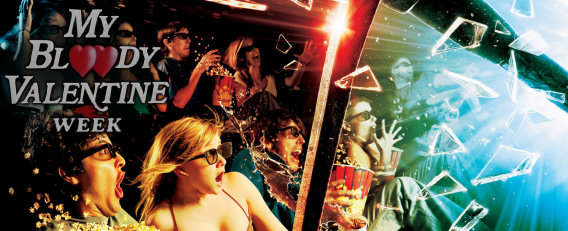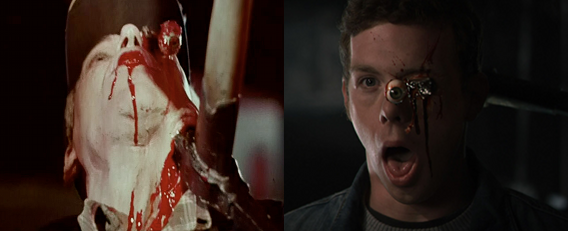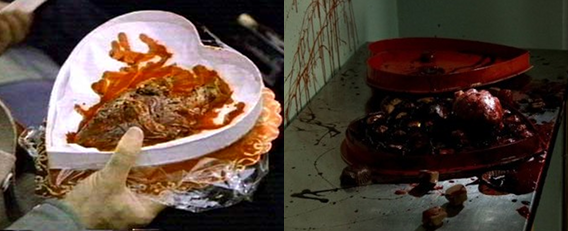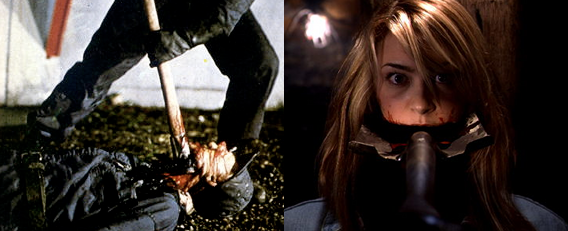
Remakes by their very definition are derivative. No matter how much a filmmaker injects new themes and ideas into a movie, the very fact that it is a recycled concept means that there will be various plot points and set pieces that resemble its predecessor, much like with a sequel. But it is how that material is handled in a new and exciting way that dictates just how effective a remake can be. John Carpenter’s decision to return to the original source material (John W. Campbell’s short story Who Goes There?) for his update of The Thing meant that his film stood on its own, whilst David Cronenberg’s reworking of The Fly boasted an intelligence and emotion lacking in its earlier counterpart. For his remake of My Bloody Valentine, Patrick Lussier decided to have fun and throw everything from pickaxes to naked flesh at the screen in groundbreaking 3-D.
“I want to be surprised when I go to a movie. Even if it’s a remake. Especially if it’s a remake,” writer Todd Farmer told me in an interview in 2008, prior to the release of My Bloody Valentine. “And the great thing about a remake is that I’m already expecting certain ideas… so… trick me. I want to be toyed with. I want to be foreplayed.” Farmer, whose prior slasher work had been the overlooked Friday the 13th sequel Jason X (“Sequels get old. Eventually the morons start running out of ideas and shoot the villain into space,” he joked about his decision of setting the latter in twenty-fifth century deep space), was brought onboard to rewrite the original script by first-timer Zane Smith, and from the very beginning the filmmakers were aware of the obligation they had to the fans to pay tribute to George Mihalka’s original classic.
“For all of us involved, we knew we wanted to keep the mining town, the love triangle and the killer,” Lussier revealed to Retro Slashers back in 2009. “Beyond that, a lot of it was fair game. I would spend time looking at the feedback on the original to see what moments were sacred, what people loved and maybe didn’t. What we should attempt to pay homage to and what we might want to do differently.” Approaching a remake is not as straightforward as it sounds. First of all, it must be decided exactly what aspects – both plot points and themes – should be recycled in the new script, whilst avoiding creating something too ‘familiar.’ Simon West made this mistake with his 2006 update of When a Stranger Calls, in which the first twenty minutes of Fred Walton’s 1979 classic were stretched out to feature length, thus failing to provide any new shocks or twists.

Prior to extensive cuts enforced by the MPAA, Mihalka’s My Bloody Valentine had been one of the more gruesome slashers of the 1980s, rivalling Paramount’s other contribution to the genre, Friday the 13th, in terms of inventive and explicit kills. It would not be until Lionsgate purchased the rights to remake the movie that much of the previously unseen footage was finally reinserted into the film. Ironically, Lussier’s version, which would feature an array of equally graphic kills, remained largely untouched by the censors when released in January 2009. Perhaps it is a sign that censorship is less prevalent in America at this time, or maybe the added aspect of 3-D made the gore less offensive, but some of the kills that Lussier would feature in his movie would echo those that Mihalka had attempted to shock audiences with, although much of the violence had been exorcised before audiences had a chance to see it.
Both films would feature a sequence in which a character’s eyeball is poked out on a spike as a pickaxe is driven into the skull, although Mihalka would choose to add a further humiliation by having his victim dragged away with the axe still embedded in his face. Another gruesome effect, and a key plot point, would be that in both movies the authorities receive a heart-shaped package, and are shocked to discover that it contains a real human heart, crudely cut from a body and still drenched in blood. One visual reference to the original movie would be in a sequence where the killer, pursuing his prey through the underground tunnels of the Hanniger Mine, uses his pickaxe to smash the lights one-by-one, slowly turning the mine to darkness.
Although the general narrative of Farmer and Smith’s script would follow the template of John Beaird’s 1981 screenplay (based on a concept by Stephen Miller), there would be several minor differences throughout that attempted to avoid merely recycling its predecessor. In the first film, T.J. Hanniger has returned home to the town of Valentine Bluffs, having attempted and failed to start a new life on the west coast, where he has found his former flame, Sarah, in the arms of fellow miner Axel Palmer. The remake saw Tom Hanniger making his way back to the mining town of Harmony after his father’s death, where he intends on selling his share of the mine, much to the anger of the local community. Sarah is now married to Axel, who has become the town sheriff, and the presence of her former childhood sweetheart angers him.

Although both films would cite an increase in methane gas as the cause for the explosion in the mine, that would become the catalyst for the carnage that would follow, the remake would indicate that it was Tom’s negligence that had caused the accident. Harry Warden, the lone survivor who had been forced to feed on the remains of his fellow miners whilst trapped underground, had returned the following year to exact his bloody vengeance, before mysteriously disappearing. In Mihalka’s film, a total of twenty years would pass between the tragedy and the murder spree that would begin when the town decide to throw a party to celebrate Valentine’s Day, whilst only ten years passed before Tom returned home in the remake. It is worth noting that, in Smith’s original draft of the 2009 movie, the plot made several significant changes from Beaird’s concept.
“The first draft had replaced the mine with a pulp mill and Harry Warden was a volunteer fireman instead of a miner,” explained Lussier. “Very quickly we all knew that it was The Miner’s story we wanted to tell and couldn’t do that without the mine. The killer in that draft was also identical to the killer of the original film. Something that all of us wrestled with and, when Todd came onboard, decided to change.” Farmer also attempted to make the characters a little less obnoxious, with the supposed protagonist of the original movie, T.J., being the jealous and somewhat aggressive ex-boyfriend. The twist in both films was that the killer is finally revealed not to be Harry Warden but one of the miners. In My Bloody Valentine, Harry has been committed to a mental institution, where he had remained for over a decade before eventually passing away, whilst in the 3-D remake Harry is chased by some of the townspeople and killed, his body buried in the woods.
The final reveal in each movie would differ somewhat; Mihalka’s killer would be Axel who, as a young boy, had witnessed his father’s death at the hands of Harry and would eventually continue his gruesome work. Lussier’s twist ending, however, would see Tom, who had spent several years in an institution following his near-death experience at the hands of Harry, taking on the role of the killer and attempting to murder his former friends (including Axel’s ex-lover, Irene). As he had done when tackling the ninth Friday the 13th sequel, Farmer had tried to pay homage to the movie he was updating, whilst also adding a hip and postmodern spin on the concept. If the box office figures were to be believed, he was successful. Slasher fans are notoriously ruthless when it comes to their favourite classics being remade, with both Halloween and Friday the 13th strongly dividing opinions, whilst Prom Night and April Fool’s Day were universally despised, yet the reaction to My Bloody Valentine was mostly positive. Perhaps because the filmmakers respected their source material but chose not to simply recycle it. Or maybe it was because of the impressive 3-D.


7 Responses to My Bloody Valentines: A Comparison